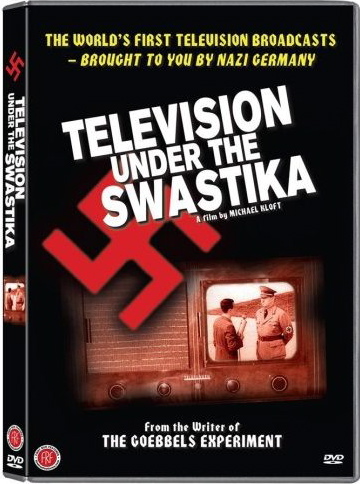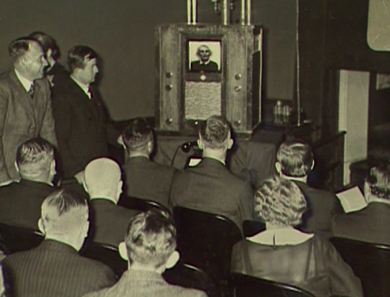| Release List | Reviews | Price Search | Shop | Newsletter | Forum | DVD Giveaways | Blu-Ray/ HD DVD | Advertise |
| Reviews & Columns |
|
Reviews DVD TV on DVD Blu-ray International DVDs Theatrical Reviews by Studio Video Games Features Collector Series DVDs Easter Egg Database Interviews DVD Talk TV DVD Talk Radio Feature Articles Columns Anime Talk DVD Savant HD Talk Horror DVDs Silent DVD
|
DVD Talk Forum |
|
|
| Resources |
|
DVD Price Search Customer Service #'s RCE Info Links |
|
Columns
|
 |
Television Under the Swastika |

|
Television Under the Swastika First Run Features 1999 / B&W & Color / 1:37 flat full frame / 52 min. / Das Fernsehen unter dem Hakenkreuz / Street Date August 19, 2008 / 29.95 Produced by Bernd Jacobs, Elvira Lind Written and Directed by Michael Kloft |
Savant has become a regular fan of filmmaker Michael Kloft, who consistently brings new perspectives to documentaries on Germany's Nazi past. His best so far remains The Goebbels Experiment, an incisive biography of Josef Goebbels from his own diary, but The Tramp and the Dictator and Firestorm are also very good. 2 In 1999's Television Under the Swastika Kloft finds his most interesting subject matter to date. Using footage recovered from German film archives, Kloft tells the story of "Deutscher Fernseh-Rundfunk", the Nazi-controlled entity that began the world's first regular television broadcasts in March of 1935. Initially given the go as a propaganda tool to spread the image and works of Adolf Hitler throughout the Reich, the broadcasts evolved from crude experiments to a variety of programming concepts. At its most popular, the Nazi TV's coverage of the 1936 Berlin Olympics reached 160,000 viewers.
The documentary is careful to qualify exactly what this infant television experiment achieved, and what it did not. The earliest broadcasts were of limited quality and prone to fits of blank-screen transmission. The first shows were pure novelty experiments using vaudeville acts, but Josef Goebbels soon put the broadcasts to work as a propaganda tool. We see a pompous labor official straining to sound important as he describes the progress of jobs in the country. The National Socialist labor corps issues stern lectures about honoring the value of menial labor, reading directly from Mein Kampf.

Since the technology to record live television didn't exist at this early date, we of course see no videotape or Kinescopes of Nazi TV shows. But much of the programming was shot on film and rush-developed for TV broadcast. We see early coverage of Nazi parades and preparations for Party rallies, all accompanied by radio-style reporters providing verbal filler to cover long waits for Hitler's motorcade, or the beginning of rally ceremonies: "let's look one more time at the stone eagles adorning the glorious entrance to the parade ground ..."
Just like our own early television coverage, the film unspools in long takes in which crowds stand patiently, and teams of photographers rush to keep up with Hitler's car. Instead of the planned (and often staged) official newsreel footage, the shaky telephoto view strains to keep its subject on camera, affording interesting unguarded views of notorious personages like Mr. and Mrs. Goering, Heinrich Himmler and Benito Mussolini. The effect of hearing the on-camera reporter identify and praise these people is chilling.
The German knack for technical innovation cannot be slighted. As early as 1936 a special TV truck shot film that was instantly developed, and then broadcast with only a minute's delay.
Special "people's TV parlors" were erected in Berlin, and became very popular during the Olympics. At first only a few high ranking bigwigs and mail officials (the TV company was subordinated to the post office) owned private Telefunken TV receivers, with their screens of eight by ten inches. One of the reporters interviewed by director Kloft explains that a party official might turn his TV on only when he wanted to impress house guests. Josef Goebbels wasn't charmed by the tiny screens and mostly left the TV people to their own devices, within limits. When Germans wanted real information, they'd turn on their radios.
The most interesting programming content is the average, everyday stuff that illuminates a society dominated by Nazi ideology. In a cooking show, the reporter interrupts some pastry work to make sure that the lady chef credits her wonderful recipes to a National Socialist homemaker's agency. A pair of horse riding instructors shout at their bumbling students, while interview subjects in uniform tend to affect a stern, sometimes fanatic manner. A comically rustic fraülein sings an awful song praising the Nazi "Strength through Joy" organization that will help her win a husband. The Nazi equivalent of Woody Guthrie sings an unpleasant ditty about the proud marching of the SA and the SS. We in America are accustomed to sober films and programming about Nazis, so it's rather unnerving to see an announcer making a "joke" about sending musicians promoting decadent foreign music to "concert camps." Cute blonde hostesses and ordinary-guy reporters greet each other -- and the camera -- with a cheery "Heil Hitler!". They might as well be saying "Hiya Toots!"

In late 1939 home TV sets are set to go into mass production for German consumers, but the war puts a quick stop to all non-essential industry. To stay in business the TV people add to their duties the mission to entertain the troops. We see some mildly erotic dancing applauded by a grateful audience of wounded young men. A weirdly touching shot shows a column of young SS troopers marching, while three tiny boys run alongside their ranks. When popular actor Heinrich George (Metropolis) is interviewed about his new state-condoned theater, he pointedly praises Hitler and the Party to the heavens. A photo of Der Führer is displayed prominently on his desk. The center of Berlin's Alexanderplatz intersection is planted with beetroot, in an effort to maximize foodstuffs during wartime shortages.
At its height the German TV is also broadcasting in occupied Paris, but the documented footage becomes lean after 1943. A fairly horrible piece shows war-wounded amputees hopping through a one-legged obstacle course, training to return to the fighting. A staged hospital recreation skit reveals a screen-full of dejected-looking wounded, while a boy dancing with a nurse unconvincingly talks about having two false legs and being optimistic about the future.
Michael Kloft's spare style divides our attention between the surviving show material and testimony describing the growth and eventual collapse of the German TV experiment. We see a number of cameras, some of them enormous. But the strongest impression of Television Under the Swastika is its unedited glimpses of life in Hitler's dictatorship. The people seem to accept what they're told and behave as if no opinion in variance with official edict would be tolerated for a moment. The heavy hand of political authority is on everything. We worry about America being dominated by controlled media, and perhaps politically influenced messages are present in our daily culture. But it's nothing like the authoritarian oppression shown here. Nothing's creepier than the way that pretty blonde flips up her hand to give her Nazi salute. It's the absolute end of psychological liberty.
First Run Features' fascinating DVD of Television Under the Swastika is short but impressive. All of the footage is in great shape. The bulk of the narration is in English, with the on-screen German translated in subtitles. I strongly recommend the documentaries of Michael Kloft, especially The Goebbels Experiment and this thought provoking, double-edged history lesson. 1
On a scale of Excellent, Good, Fair, and Poor,
Television Under the Swastika rates:
Movie: Excellent
Video: Excellent
Sound: Excellent
Supplements: promos
Packaging: Keep case
Reviewed: September 3, 2008
Footnotes:
1. It's especially important that the fair-minded tone of these docus is being managed by a German writer-director. In my contact with German readers, two have told me that they have little experience with Third Reich- themed documentaries, indicating perhaps that war history-related programming isn't as ubiquitous in Germany as it is here. American and English docus are certainly fair, but they're almost exclusively concerned with nationalistic messages, to the exclusion of the experience of normal citizens in the 'enemy' nations.
Return
2. I'm aware that Michael Kloft is not the sole talent behind these documentaries. The Tramp and the Dictator was co-directed by Kevin Brownlow. Kloft is the co-writer of The Goebbels Experiement; its director is Lutz Hachmeister.
Return
Reviews on the Savant main site have additional credits information and are more likely to be updated and annotated with reader input and graphics.
Review Staff | About DVD Talk | Newsletter Subscribe | Join DVD Talk Forum
Copyright © MH Sub I, LLC dba Internet Brands. | Privacy Policy
Subscribe to DVDTalk's Newsletters
|
| Release List | Reviews | Price Search | Shop | SUBSCRIBE | Forum | DVD Giveaways | Blu-Ray/ HD DVD | Advertise |





